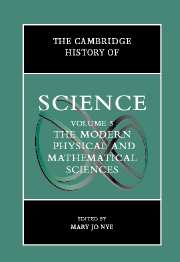Book contents
- Frontmatter
- Introduction: The Modern Physical and Mathematical Sciences
- Part I The Public Cultures of the Physical Sciences After 1800
- Part II Discipline Building in the Sciences: Places, Instruments, Communication
- Part III Chemistry and Physics: Problems Through the Early 1900s
- Part IV Atomic and Molecular Sciences in the Twentieth Century
- Part V Mathematics, Astronomy, and Cosmology Since the Eighteenth Century
- Part VI Problems and Promises at the End of the Twentieth Century
- 29 Science, Technology, and War
- 30 Science, Ideology, and the State
- 31 Computer Science and the Computer Revolution
- 32 The Physical Sciences and the Physician’s Eye: Dissolving Disciplinary Boundaries
- 33 Global Environmental Change and the History of Science
- Index
- References
32 - The Physical Sciences and the Physician’s Eye: Dissolving Disciplinary Boundaries
from Part VI - Problems and Promises at the End of the Twentieth Century
Published online by Cambridge University Press: 28 March 2008
- Frontmatter
- Introduction: The Modern Physical and Mathematical Sciences
- Part I The Public Cultures of the Physical Sciences After 1800
- Part II Discipline Building in the Sciences: Places, Instruments, Communication
- Part III Chemistry and Physics: Problems Through the Early 1900s
- Part IV Atomic and Molecular Sciences in the Twentieth Century
- Part V Mathematics, Astronomy, and Cosmology Since the Eighteenth Century
- Part VI Problems and Promises at the End of the Twentieth Century
- 29 Science, Technology, and War
- 30 Science, Ideology, and the State
- 31 Computer Science and the Computer Revolution
- 32 The Physical Sciences and the Physician’s Eye: Dissolving Disciplinary Boundaries
- 33 Global Environmental Change and the History of Science
- Index
- References
Summary
When medical technology met computers in the last third of the twentieth century, the conjoining triggered changes almost as radical as the ones that followed the discovery of x rays in 1895. As in that earlier revolution, the greatest change was in the realm of vision. Whereas x rays and fluoroscopy allowed physicians to peer into the living body to see foreign objects, or tumors and lungs disfigured by tuberculosis (TB), the new digitized images locate dysfunction deep inside organs, like the brain, that are opaque to x rays. The initial medical impact of these new devices, like the x ray before it, was in diagnosis.
Wilhelm Conrad Röntgen’s (1845–1923) announcement of the discovery of x rays in 1896 was probably the first scientific media event. Within months, x-ray apparatus was hauled into department stores, and slot machine versions were installed in the palaces of kings and tsars, and in railroad stations for the titillation of the masses. Although the phenomenon had been discovered by a physicist who had no interest in either personal profit or any practical application, it was obvious to physicians and surgeons, as well as to those who sold them instruments, how the discovery could help make diagnoses.
The advantages seemed so great that, for the most part, purveyors of x- ray machines were either oblivious to the dangers of radiation or able to find alternative explanations for burns and ulcerating sores that kept appearing. Even so, with the exception of military medicine, exemplified in the United States by the use of x rays during the Spanish-American war, the machines were not employed routinely in American hospitals for at least a decade after their discovery.
- Type
- Chapter
- Information
- The Cambridge History of Science , pp. 615 - 633Publisher: Cambridge University PressPrint publication year: 2002



